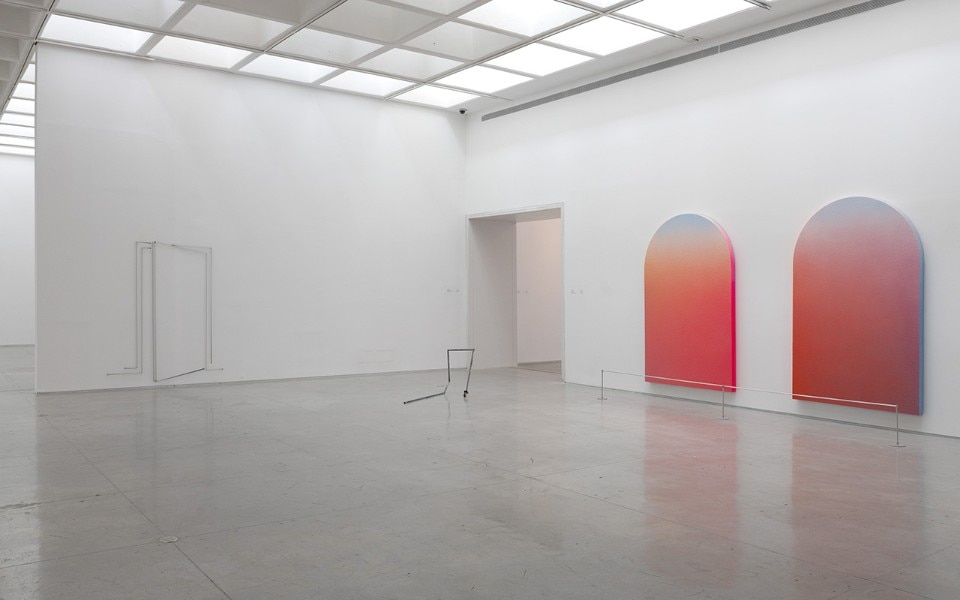At Israel Museum, does observing a work of art bring about the opening of an imaginary window? Presented in the gallery space, the shutter, window handle, and stairs – whose dimensions correspond to the human body – invite visitors to take a closer look, as though they have burst out from the unconscious realm of quotidian existence and are demanding our undivided attention. "Shutters and Stairs Elements of Modern Architecture in Contemporary Art" encompasses also Alex Israel’s Untitled (Two Flats), 2014 refers to the exterior walls of typical buildings of the Los Angeles architectural scene. The work consists of two opaque panels that are a cross between an opening, or a window, and a wall – since they are shaped like a gate or window, but their surface is covered with rough stucco texture of an exterior wall. The colour gradient on these walls is reminiscent of powder-blush makeup, also presenting a kind of artificial Los Angeles sunset. Alex Israel, whose art engages with Hollywood culture, produced the work surfaces in the film-set construction workshop of the Warner Bros. Studios in Hollywood, and he uses them as the set for a celebrity talk-show called As It Lays that he edits and hosts, or as a backdrop for his objects and sculptures at exhibitions – much as studio photographers in the past would place painted backdrops behind the people they photographed.
Architecture, from its grand manifestations to its small, intimate details, shapes our physical environment. In this architecturally designed space, we move about habitually, without paying close attention to what is around us, without actively gazing at our surroundings. Architecture is always in the back of our consciousness. But since we cannot take in the entire environment (or building) at a glance, our spatial orientation depends on our ability to glean information from meaningful details, such as a door, or a window handle.
An examination of Israel Museum acquisitions from recent years has uncovered an interesting phenomenon: contemporary artists directing their attention not to an entire architectural structure (or a part of it), but to a single isolated element – such as a floor, wall, door, or staircase – whose design is typical of modernist architecture.

Renata Lucas’s Carpet, 2013, is a thin rectangular slab of cast concrete floor that partially covers an early Twentieth Century Turkish carpet, that lies beneath it. Perfectly matching the texture and color of the gallery’s concrete floor, it can be perceived as a rectangular replication of a section of that floor – cut out, much like the photographic act of framing, but by concrete physical means. Lucas’s smooth concrete surface, the desirable attribute of contemporary art spaces around the world, creates an assemblage with the Oriental floor carpet, which embodies past notions of opulence and good taste. The work is a juxtaposition of two disparate types of floorcovering: one modern, the other traditional; one industrial, the other handmade.
Lucas’s decision to complete the carpet’s rectangle with a slab of industrial concrete is a deviation or disruption that highlights 8 “Reinforced concrete buildings are by nature skeletal buildings.... A construction of girders that carry the weight, and walls that carry no weight. That is to say, buildings consisting of skin and bones.” Ludwig Mies van der Rohe, “Working Theses” [1923], Programs and Manifestoes on Twentieth-Century Architecture, ed. Ulrich Conrads (Cambridge, MA: MIT Press, 1970), p. 75. our habitual obliviousness to the floor surface beneath our feet. The carpet softens and cushions our feet’s contact with the floor – and the concrete flooring that Lucas places on top of it makes it look all the harder and unyielding. Her slab of smooth concrete, with its rectangular shape, is a pithy and polarizing encapsulation of modernism, modern architecture, and photography, all at once.
Each of the works in the exhibition offers an encounter with such an element and with the conceptual underpinnings of its transposition from real life to the context of art. The materials of which they are made and their treatment underscore the materiality of the represented elements and draw our attention to small details that often elude us. Inspired by modernist architecture, many of the works recall the geometric abstraction of twentieth-century art. Like photography, which is an act of framing and exclusion, the works on view appear to have been cut out of the vast expanse of the world and cast upon the museum wall or floor.
- Title:
- Shutters and Stairs Elements of Modern Architecture in Contemporary Art
- Exhibition dates:
- February–October 2020
- Curated by:
- Aya Miron
- Artists:
- Joshua Borkovsky, Shibetz Cohen, Jesse Darling, Yael Efrati, Asaf Elkalai, Assaf Evron, Tsibi Geva, Matan Golan, Olivia Hild, Alex Israel, Renata Lucas, Saher Miari, Moshe Ninio, Roman Ondák, Hadar Saifan, Fred Sandback, Ariel Schlesinger, Gil Marco Shani, Hilla Toony Navok, Yonatan Vinitsky, Noa Yafe, Shay Zilberman, Jonathan Zofy
- Venue:
- Israel Museum, Ayala Zacks Abramov Pavilion for Israeli Art
- Address:
- Derech Ruppin 11, Jerusalem, Israel









